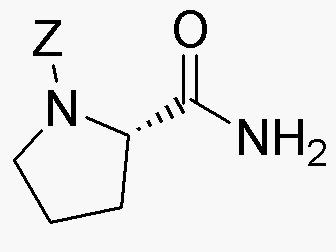Z-L-proline amide is widely utilized in research focused on:
- Peptide Synthesis: This compound serves as a valuable building block in the synthesis of peptides, which are essential in drug development and biological research.
- Pharmaceutical Applications: It is used in the formulation of pharmaceuticals, particularly in creating compounds that target specific biological pathways, enhancing therapeutic efficacy.
- Protein Folding Studies: Researchers use Z-L-proline amide to investigate protein folding mechanisms, which is crucial for understanding diseases related to protein misfolding.
- Chiral Catalysis: This compound is employed in asymmetric synthesis as a chiral catalyst, providing advantages in producing enantiomerically pure compounds, which are important in the pharmaceutical industry.
- Biochemical Research: It plays a role in various biochemical assays, helping scientists explore enzyme activity and interactions, thereby advancing our understanding of metabolic processes.
General Information
Properties
Safety and Regulations
Applications
Z-L-proline amide is widely utilized in research focused on:
- Peptide Synthesis: This compound serves as a valuable building block in the synthesis of peptides, which are essential in drug development and biological research.
- Pharmaceutical Applications: It is used in the formulation of pharmaceuticals, particularly in creating compounds that target specific biological pathways, enhancing therapeutic efficacy.
- Protein Folding Studies: Researchers use Z-L-proline amide to investigate protein folding mechanisms, which is crucial for understanding diseases related to protein misfolding.
- Chiral Catalysis: This compound is employed in asymmetric synthesis as a chiral catalyst, providing advantages in producing enantiomerically pure compounds, which are important in the pharmaceutical industry.
- Biochemical Research: It plays a role in various biochemical assays, helping scientists explore enzyme activity and interactions, thereby advancing our understanding of metabolic processes.
Documents
Safety Data Sheets (SDS)
The SDS provides comprehensive safety information on handling, storage, and disposal of the product.
Product Specification (PS)
The PS provides a comprehensive breakdown of the product’s properties, including chemical composition, physical state, purity, and storage requirements. It also details acceptable quality ranges and the product's intended applications.
Certificates of Analysis (COA)
Search for Certificates of Analysis (COA) by entering the products Lot Number. Lot and Batch Numbers can be found on a product’s label following the words ‘Lot’ or ‘Batch’.
*Catalog Number
*Lot Number
Certificates Of Origin (COO)
This COO confirms the country where the product was manufactured, and also details the materials and components used in it and whether it is derived from natural, synthetic, or other specific sources. This certificate may be required for customs, trade, and regulatory compliance.
*Catalog Number
*Lot Number
Safety Data Sheets (SDS)
The SDS provides comprehensive safety information on handling, storage, and disposal of the product.
DownloadProduct Specification (PS)
The PS provides a comprehensive breakdown of the product’s properties, including chemical composition, physical state, purity, and storage requirements. It also details acceptable quality ranges and the product's intended applications.
DownloadCertificates of Analysis (COA)
Search for Certificates of Analysis (COA) by entering the products Lot Number. Lot and Batch Numbers can be found on a product’s label following the words ‘Lot’ or ‘Batch’.
*Catalog Number
*Lot Number
Certificates Of Origin (COO)
This COO confirms the country where the product was manufactured, and also details the materials and components used in it and whether it is derived from natural, synthetic, or other specific sources. This certificate may be required for customs, trade, and regulatory compliance.


